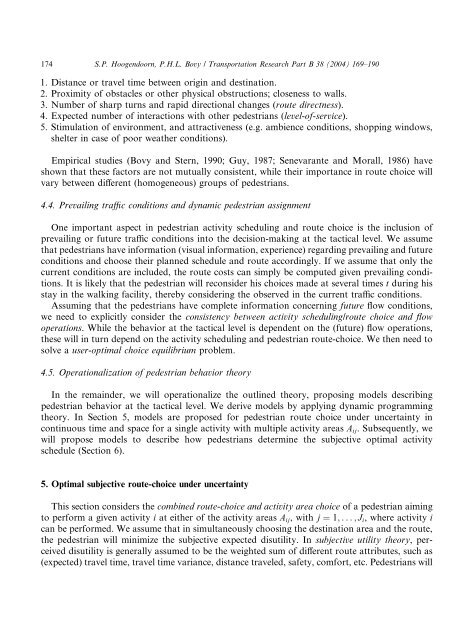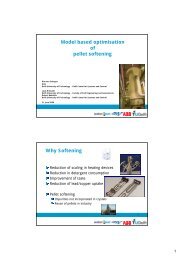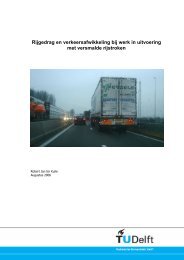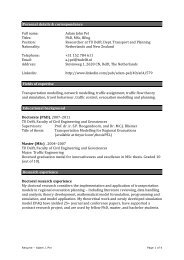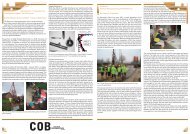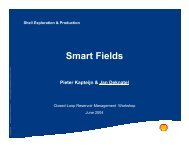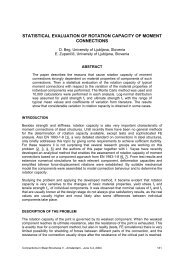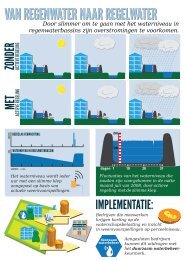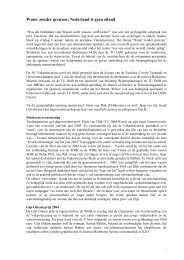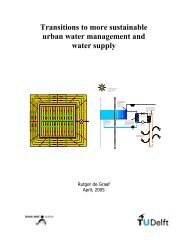Pedestrian route-choice and activity scheduling theory and models
Pedestrian route-choice and activity scheduling theory and models
Pedestrian route-choice and activity scheduling theory and models
You also want an ePaper? Increase the reach of your titles
YUMPU automatically turns print PDFs into web optimized ePapers that Google loves.
174 S.P. Hoogendoorn, P.H.L. Bovy / Transportation Research Part B 38 (2004) 169–190<br />
1. Distance or travel time between origin <strong>and</strong> destination.<br />
2. Proximity of obstacles or other physical obstructions; closeness to walls.<br />
3. Number of sharp turns <strong>and</strong> rapid directional changes (<strong>route</strong> directness).<br />
4. Expected number of interactions with other pedestrians (level-of-service).<br />
5. Stimulation of environment, <strong>and</strong> attractiveness (e.g. ambience conditions, shopping windows,<br />
shelter in case of poor weather conditions).<br />
Empirical studies (Bovy <strong>and</strong> Stern, 1990; Guy, 1987; Senevarante <strong>and</strong> Morall, 1986) have<br />
shown that these factors are not mutually consistent, while their importance in <strong>route</strong> <strong>choice</strong> will<br />
vary between different (homogeneous) groups of pedestrians.<br />
4.4. Prevailing traffic conditions <strong>and</strong> dynamic pedestrian assignment<br />
One important aspect in pedestrian <strong>activity</strong> <strong>scheduling</strong> <strong>and</strong> <strong>route</strong> <strong>choice</strong> is the inclusion of<br />
prevailing or future traffic conditions into the decision-making at the tactical level. We assume<br />
that pedestrians have information (visual information, experience) regarding prevailing <strong>and</strong> future<br />
conditions <strong>and</strong> choose their planned schedule <strong>and</strong> <strong>route</strong> accordingly. If we assume that only the<br />
current conditions are included, the <strong>route</strong> costs can simply be computed given prevailing conditions.<br />
It is likely that the pedestrian will reconsider his <strong>choice</strong>s made at several times t during his<br />
stay in the walking facility, thereby considering the observed in the current traffic conditions.<br />
Assuming that the pedestrians have complete information concerning future flow conditions,<br />
we need to explicitly consider the consistency between <strong>activity</strong> <strong>scheduling</strong>/<strong>route</strong> <strong>choice</strong> <strong>and</strong> flow<br />
operations. While the behavior at the tactical level is dependent on the (future) flow operations,<br />
these will in turn depend on the <strong>activity</strong> <strong>scheduling</strong> <strong>and</strong> pedestrian <strong>route</strong>-<strong>choice</strong>. We then need to<br />
solve a user-optimal <strong>choice</strong> equilibrium problem.<br />
4.5. Operationalization of pedestrian behavior <strong>theory</strong><br />
In the remainder, we will operationalize the outlined <strong>theory</strong>, proposing <strong>models</strong> describing<br />
pedestrian behavior at the tactical level. We derive <strong>models</strong> by applying dynamic programming<br />
<strong>theory</strong>. In Section 5, <strong>models</strong> are proposed for pedestrian <strong>route</strong> <strong>choice</strong> under uncertainty in<br />
continuous time <strong>and</strong> space for a single <strong>activity</strong> with multiple <strong>activity</strong> areas A ij . Subsequently, we<br />
will propose <strong>models</strong> to describe how pedestrians determine the subjective optimal <strong>activity</strong><br />
schedule (Section 6).<br />
5. Optimal subjective <strong>route</strong>-<strong>choice</strong> under uncertainty<br />
This section considers the combined <strong>route</strong>-<strong>choice</strong> <strong>and</strong> <strong>activity</strong> area <strong>choice</strong> of a pedestrian aiming<br />
to perform a given <strong>activity</strong> i at either of the <strong>activity</strong> areas A ij , with j ¼ 1; ...; J i , where <strong>activity</strong> i<br />
can be performed. We assume that in simultaneously choosing the destination area <strong>and</strong> the <strong>route</strong>,<br />
the pedestrian will minimize the subjective expected disutility. In subjective utility <strong>theory</strong>, perceived<br />
disutility is generally assumed to be the weighted sum of different <strong>route</strong> attributes, such as<br />
(expected) travel time, travel time variance, distance traveled, safety, comfort, etc. <strong>Pedestrian</strong>s will


